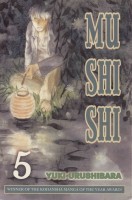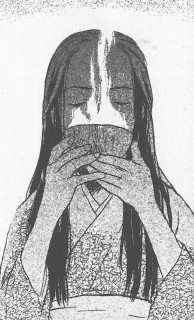 Creator: Yuki Urushibara
Creator: Yuki Urushibara
U.S. publisher: Del Rey
ISBN: 9780345501387
Released: August 2008
Original release: 2004
Awards: Japan Media Arts Award, Kodansha Manga Award
The manga series Mushishi was Yuki Urushibara’s professional debut as a mangaka. The manga began serialization in Japan in 1999, lasted for ten volumes, and was the basis for multiple anime adaptations and a live-action film in addition to other media. Over the course of its publication, Mushishi would earn Urushibara several awards and honors, including a Japan Media Arts Award in 2003 and a Kodansha Manga Award in 2006. Mushishi, Volume 5 was originally published in Japan in 2004. The English-language edition of the volume was initially released in print by Del Rey Manga in 2008 and then in an electronic format by Kodansha Comics in 2014. Mushishi is one of my favorite manga series and one of the first that I made a point to collect in its entirety. Fortunately, I discovered the series as it was first being published in English, so I was able to complete my set before the manga went out-of-print and became expensive to find. However, I am glad that the digital version is now available for readers who missed the series’ original run in English, though.
Mushishi, Volume 5 collects five stories which, as is usual for the series, largely stand on their own. Ginko’s doctor friend makes a brief reappearance and there are a few nods to some of the series’ previous chapters, such as those exploring Ginko’s past, but it’s not necessary to be familiar with those references to enjoy the stories in the fifth volume. In “The Sea Palace,” Ginko visits a remote island where it is rumored that people are reborn after they die, suspecting that mushi may involved. His search for unusual mushi continues in “Eye’s Fortune, Eye’s Misfortune” when he happens upon a clairvoyant traveling musician with quite a story to tell—blind as a child, she credits a mushi for giving her sight. “The Coat That Holds a Mountain” follows an aspiring artist who leaves his rural village to study in the city, his success coming with unanticipated consequences and costs. In “Flames of the Fields,” a village’s mushishi makes a drastic decision when an unknown, invasive grass threatens lives and livelihoods. Finally, in “The Snake of Dawn,” Ginko is asked to do what he can to help a young mother who is slowly losing all of her memories.
 As a mushishi, Ginko travels across Japan striving to learn as much as he can about mushi. Some mushishi see the creatures as little more than dangerous pests that need to be eradicated. Ginko, however, approaches mushi more liberally, recognizing the need to treat them with caution but also advocating for the sanctity of all life and for the coexistence between humans and mushi whenever possible. Mushishi, Volume 5 presents several scenarios in which this harmony has actually been achieved: mushi that facilitate life, mushi that provide healing, mushi that grant health and strength. In some cases, though the results may still be tragic, what would normally be seen as an unwanted side-effect of interacting with a particular mushi can be used to a person’s advantage. But the fifth volume also shows that people must still continue to be vigilant and take great care when dealing with mushi and their powerful influences. This is a concept that of course extends beyond the mushi themselves; mushi are both representative of and a metaphor for those things which humans don’t fully understand or know.
As a mushishi, Ginko travels across Japan striving to learn as much as he can about mushi. Some mushishi see the creatures as little more than dangerous pests that need to be eradicated. Ginko, however, approaches mushi more liberally, recognizing the need to treat them with caution but also advocating for the sanctity of all life and for the coexistence between humans and mushi whenever possible. Mushishi, Volume 5 presents several scenarios in which this harmony has actually been achieved: mushi that facilitate life, mushi that provide healing, mushi that grant health and strength. In some cases, though the results may still be tragic, what would normally be seen as an unwanted side-effect of interacting with a particular mushi can be used to a person’s advantage. But the fifth volume also shows that people must still continue to be vigilant and take great care when dealing with mushi and their powerful influences. This is a concept that of course extends beyond the mushi themselves; mushi are both representative of and a metaphor for those things which humans don’t fully understand or know.
I particularly enjoy the strong influence that Japanese folklore and legends have had on Mushishi. Some of the chapters take direct inspiration from existing stories while others easily fit in with those traditional tales. But there’s another aspect of Mushishi that I find especially interesting because in some way it runs counter to its seemingly supernatural elements—the actual study of mushi. In part, to be a mushishi is to be a scientist and a researcher, someone who pursues and gathers knowledge. Much of Mushishi, Volume 5 deals with rarer and unknown mushi. By investigating them, Ginko and other mushishi are in a better position to make more informed decisions in situations in which mushi are involved. Acting without complete understanding can be extremely dangerous, therefore knowledge is an incredibly powerful and valuable tool granting some amount of control over the world. Mushishi realize how important and vital the accumulation of knowledge truly is and they take their chose profession very seriously.

Heya! I’m looking for Manga and Anime bloggers and stumbled on your blog. I could not find your email here, can you please send me an email: alysonburston[at]live.com — It is regarding writing about Anime & Manga type of offer. This isn’t spam btw. Thanks.
Try the Contact page. ;)
Love, love, love Mushishi. Glad to see it getting such a thoughtful review!
As do I! (And thank you for the kind words!) I really wish Mushishi was still available in print so that I could literally put it into people’s hands; having it digitally is great, but just not the same.